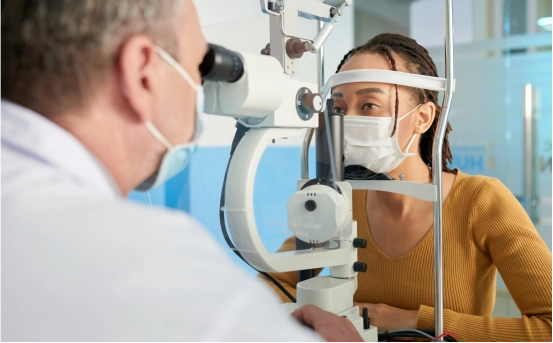Refractive Lens Exchange (RLE) surgery has emerged as a powerful alternative for individuals who are not suitable candidates for LASIK or PRK. Often considered a solution for aging eyes or people with high refractive errors, this procedure offers a permanent and clear vision without the need for glasses or contact lenses.
That’s where Refractive Lens Exchange (RLE) surgery comes in a modern, advanced vision correction option that offers a long term solution. Also known as Clear Lens Extraction (CLE) or Lens Replacement Surgery, RLE involves replacing your eye’s natural lens with an artificial intraocular lens (IOL) designed to correct your specific refractive error. Think of it as a two in one procedure: it restores clear vision and also eliminates the possibility of developing cataracts in the future.
What is Refractive Lens Exchange Surgery?
Refractive Lens Exchange (RLE), also known as lens replacement surgery or clear lens extraction, is a surgical procedure where the eye’s natural lens is removed and replaced with an artificial intraocular lens (IOL). This procedure is very similar to cataract surgery the only difference is that RLE is performed even when the natural lens is still clear, mainly to correct refractive errors like nearsightedness, farsightedness, and presbyopia.
The goal of RLE is to reduce or eliminate the need for glasses or contact lenses by correcting the refractive power of the eye. It is particularly beneficial for individuals over 40 who have age-related changes in vision and are not eligible for laser vision correction.
Who is a Good Candidate for RLE Surgery?
Refractive Lens Exchange is ideally suited for individuals :-
-
Over the age of 40 or 45 with presbyopia (difficulty focusing on near objects)
-
With high degrees of hyperopia (farsightedness) or myopia (nearsightedness)
-
Who are not suitable for LASIK or PRK due to thin corneas or other corneal irregularities
-
With early-stage cataracts, where RLE can serve both as a refractive and cataract solution
It’s important to have a comprehensive eye exam with an ophthalmologist who will evaluate your eye health, corneal thickness, refractive error, and overall suitability for the procedure.
Types of Intraocular Lenses (IOLs) Used in RLE
One of the significant benefits of RLE surgery is the availability of various intraocular lenses tailored to different vision needs. The main types of IOLs include :-
-
Monofocal IOLs :- These lenses offer clear vision at a single distance usually for far, intermediate, or near tasks. Most people choosing monofocal lenses may still need glasses for certain activities.
-
Multifocal IOLs :- These lenses are designed to provide vision at multiple distances, reducing or even eliminating the need for glasses entirely.
-
Toric IOLs :- These are specialized lenses that correct astigmatism in addition to nearsightedness or farsightedness.
Your ophthalmologist will help you select the best IOL based on your lifestyle, vision needs, and expectations.
The Refractive Lens Exchange Procedure
Refractive Lens Exchange is typically performed as an outpatient procedure and takes about 15 to 30 minutes per eye. Here’s how the process generally works :-
-
Preparation :- Before the surgery, numbing eye drops are administered to ensure a painless experience. You’ll be awake but relaxed throughout the procedure.
-
Lens Removal :- A small incision is made at the edge of the cornea. Using a process called phacoemulsification, the natural lens is gently broken up and removed from the eye.
-
Lens Replacement :- The chosen intraocular lens is then inserted through the same incision. It unfolds inside the eye and is positioned securely.
-
Post-Procedure :- The incision is self-sealing and usually does not require stitches. The patient can go home the same day, although someone must accompany them.
In most cases, RLE is done one eye at a time, with the second eye scheduled a week or two later.
Benefits of Refractive Lens Exchange Surgery
RLE offers numerous advantages that go beyond simple vision correction. Some of the most notable benefits include :-
-
Permanent Vision Correction :- Since the natural lens is replaced, the results are stable and permanent.
-
Prevention of Cataracts :- As the natural lens is removed, patients will never develop cataracts in the future.
-
Improved Quality of Life :- Reduced dependency on glasses or contact lenses for daily tasks, reading, or driving.
-
Customized Vision :- The choice of IOL allows for tailored vision correction to suit individual needs.
For many, RLE offers the dual advantage of restoring youthful vision while preventing future cataract surgery.
Risks and Considerations
Like all surgeries, Refractive Lens Exchange has potential risks and complications, although they are relatively rare when performed by an experienced ophthalmologist. Possible risks include :-
-
Infection
-
Retinal detachment (especially in highly myopic patients)
-
Glare or halos around lights
-
Inflammation
-
IOL dislocation
A detailed pre-surgical assessment and proper post operative care can significantly minimize these risks. It’s essential to have realistic expectations and discuss all potential outcomes with your eye surgeon.
What to Expect During Recovery?
Recovery from RLE surgery is generally quick and straightforward. Most people notice an improvement in their vision within a few days. Here are some common recovery guidelines :-
-
Avoid rubbing your eyes or engaging in strenuous activities for at least a week.
-
Use prescribed eye drops to prevent infection and reduce inflammation.
-
Attend all follow-up appointments to ensure proper healing.
While some mild discomfort, dryness, or blurriness may be experienced initially, these symptoms usually resolve within a few days. Full visual stabilization may take a few weeks.
Is Refractive Lens Exchange Right for You?
If you are over 40, tired of constantly switching between glasses or contacts, and want a long term solution to vision correction, Refractive Lens Exchange might be the ideal option. It’s especially suitable for those who are not LASIK candidates or those looking to eliminate the possibility of cataracts later in life.
Before making a decision, consult a qualified ophthalmologist or refractive surgeon who can guide you through the evaluation and explain whether RLE is a safe and effective choice based on your eye health.
Conclusion
Refractive Lens Exchange surgery is a life changing vision correction procedure that offers clear, stable, and long lasting results. With the added advantage of cataract prevention, it is a powerful option for middle aged and older adults seeking spectacle free vision. As with any medical procedure, proper screening and the right surgeon make all the difference in achieving successful outcomes.























